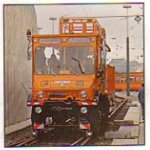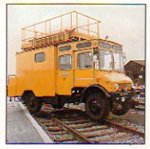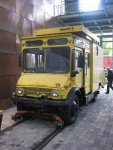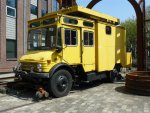- Forums
- Classified
- For Sale and Wanted Section
- Expedition Vehicles
- For sale - By ExPo members (*With Price*)
You are using an out of date browser. It may not display this or other websites correctly.
You should upgrade or use an alternative browser.
You should upgrade or use an alternative browser.
It's Baaack! And Gone Again! Highly-Capable 416-Based Unimog Expedition Motorhome
- Thread starter mhiscox
- Start date
The $10k that squeezr bought it for sounds like an even better deal!
$24k and it still needs the engine installed?
Just how much was that used engine? :Wow1:
I paid a bit more than that...
The engine was $169,000 came with a combine attached.
smurf40
Observer
Hi, I have watched that truck for many years. Nearly bought it from Mike (Hi Mike!) some time ago. I have seen and driven this truck just before he sold it. Does it still have all the gear that he had with it? eg: Generator, back up camera, 2 small AC units, DVD, tools, etc etc etc. Mike had it pretty kitted out. How much is left now? Thanks
Hi, I have watched that truck for many years. Nearly bought it from Mike (Hi Mike!) some time ago. I have seen and driven this truck just before he sold it. Does it still have all the gear that he had with it? eg: Generator, back up camera, 2 small AC units, DVD, tools, etc etc etc. Mike had it pretty kitted out. How much is left now? Thanks
Embarrassingly enough I have not gone through all the compartments to see if everything is still in place. The generator is sitting in my garage and gets started every few months on stabilized fuel, the Mog specific tools are for sure there and yes the A/V equipment is also in place. The AC units were replaced with skylights or fantastic fans.
mhiscox
Exp. Leader Emeritus
The Coleman Polar Cub air conditioner I had was a sometimes thing. It had a standard 14" x 14" outlet into the cabin, so I would install the AC iin the summer through the fan/vent skylight, and then take it back out again when fall hit since the light through the skylight was useful. However, between the time I first sold the Mog and the time it was picked it up from Valley Freightliner, the Polar Cub went AWOL, if I recall correctly. (Though I may not, as it's been a while.)The AC units were replaced with skylights or fantastic fans.
FWIW, I also experimented with putting a regular window air conditioner--a remote-controlled Sharp unit of about 10K BTUs--into one of the front storage compartments which, as you may know from the pictures, are usefully open to the cabin as well as the exterior. I used some cut-up insulation board and some wood supports to make it so the back (warm air exhaust) of the AC was open to the outside air once the compartment panel was off, while the front could exhaust cold air into the cabin. It was a pretty good idea. The window AC was more energy efficient and way quieter than the Polar Cub, though the low/forward positioning of the cold air flow wasn't quite optimal. However, the biggest issue as to whether to go this route would be whether you needed the handy storage area for something more important, and many people would. The roof AC approach took up no interior storage.
Also, FWIW, note that there's nothing that precludes leaving the fan/skylight and putting in a separate roof air. However, as it sits, the wide, flat strong rear section of the cabin roof can easily accommodate any type of roof top tent, from a fold-open canvas model to an Autohome to a backpacking tent (or even just a sleeping mat), all of which would provide even more sleeping spaces, as well as a very secure under-the-stars place to optionally bed down. It's also a great place for sunbathing, watching the races, lounging safe from the scorpions/snakes/gators, etc.. So while cutting more holes in the roof would have been good for my individual use, the open roof area is so potentially useful that I couldn't see messing with it.
Chris/Squeezer:
Can you tell us a little bit about what it's going to take to shoehorn the turbo OM352 into engine bay? What sorts of problems do you foresee, ie, what doesn't fit? What workarounds have you come up with? What flat-out unknowns have you forseen? Thanks.
First the cab needs to be lifted instead of tilted (unless you have a 30' ceiling in your shop... Not the end of the world but consider splicing in harness connectors before pulling the cab to make the install go easier...
Fitting the turbo... Two ways to do that, lift the cab about 2" or rebuild the dog house. I would lift the cab as it provides easier access and better airflow. The overall height of the truck remains the same and there is already a step in the walk through.
mhiscox
Exp. Leader Emeritus
Yeah, I know I'm not Chris, but I've got more of the coveted "free time" than he does, and it ain't like I didn't give the matter considerable thought before selling to him, so I'll take a first cut at the answer and he can add whatever he wants.Chris/Squeezer: Can you tell us a little bit about what it's going to take to shoehorn the turbo OM352 into engine bay? What sorts of problems do you foresee, ie, what doesn't fit? What workarounds have you come up with? What flat-out unknowns have you forseen?
So . . . the engine swap will be easy. No, really. The engine will bolt into place on the very same mounts, and the engine, predating electronic controls as it does, has none of the electrical/computer issues that have to be dealt with during a modern engine swap. Unless Chris's dog ate them, the full official (read: expensive) Mercedes shop manuals will come with the truck, so you'll have instructions and photos to follow. And the engine compartment isn't particularly tight, plus the number things mounted onto the engine that would need to be swapped over is pretty small. And no emissions equipment to hassle. Yep, just lift the cab off and straightforwardly bolt the engine in.
Whoa!
Lift the cab? Yes sir, that's how the engine comes in and out on a 416, and the shop manual has complete instructions on where the stock cab's bolts need to be removed, wires disconnected and so on. So if Camper Mog had the cramped pickup-style cabin routinely on 416 DoKas, like this, you'd know exactly what to do.
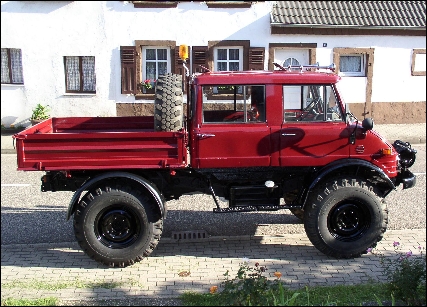
Image credit: Classic Unimogs (the original restorer of Camper Mog in 2001; go here http://www.classicunimogs.com/unimog_416doka_camper.html to see the original sale page which they've left up.)
But Camper Mog doesn't have that tiny little cab; it has this big, roomy, near-stand-up height cab with trick sliding doors, expansive views, four cushy seats and yada-yada . . .
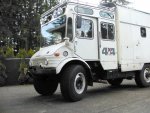
and it was one of only five such cabs ever built by the German coachbuilder Hartmann, and they were all made for the Netherlands Railway Authority and who knows where the other four are now. Which is to say that the people who know for certain how this cab comes off are probably all in Europe and likely retired.
There's no reason to think it would be particularly difficult. Maybe it's as simple as undoing a dozen perfectly obvious bolts. Of course, lifting the cab up will be a lot easier with access to a crane than attempting to sling a rope and pulley over a convenient branch and buying beer to bribe six strong friends into pulling on the rope. Having an overhead crane straddle the Mog would be super good, because then it could lift the engines in and out as well. No reason, though, that a rented crane couldn't stop by to lift it off and come back later to set it back on.
Which brings up the second tricky issue. The turbocharged engine Chris is providing is a wonderful improvement over normally aspirated, especially if you want to take it to places with higher elevations than the Netherlands. The stock engine loses, I believe, 3% of it's power for every 1000 feet of elevation gain. So you absolutely want the turbocharger. However, the turbocharger sits above the engine, making the overall engine height 4 inches taller. Since there was no extra space under the firewall and doghouse, a four-inch cab lift is needed. As with the cab removal, there's no reason to think it's rocket science to engineer and fabricate the lift, but you can't just order up the parts and bolt them in. (It might be possible to "remote" the turbocharger to avoid the cab lift, but that would be closer to rocket science and I can't comment on whether it is practical or would work well.)
Unless Chris's dog ate it, too, I recall that there's a paper-covered binder that has a lot of engineering drawings from the builder. They're really first-rate (read: complicated with tiny print) drawings and there are many of them and it's entirely possible that they would provide the information needed about how to unbolt the cab. But they are in German and I haven't looked at them in ten years, so I don't know. They may not even be necessary, though. Maybe spending thirty minutes on your back under the cab studying the matter is all that it takes.
The point being that there's no reason to think that the engine swap would be particularly difficult, but it's never been done with this cab configuration, and "I don't see any reason there should be problems" ranks really high on the Famous Last Words list, for sure. But there are no electronics or computers involved; it's likely just a matter of big wrenches and couple quarts of penetrating oil and a way to get the cab raised and lowered.
This may not be the ideal project to turn over to the Freightliner dealer to have them charge $105/hour while they puzzle through what to do. It'd be a better project for someone willing to stare at things for a little while to figure out the optimum approach and then go at it at a steady pace. There aren't any specialist tools or diagnostic testers involved, and no chance that you'd be spending months trying to get rid of a error code or Check Engine light. The swap doesn't even require diesel expertise, as nothing internal is being done, and the procedures for priming the engine, etc. are in the owner's manual.
A full-on expedition camper with Camper Mog's unique, and really brilliant, cab configuation is otherwise unavailable, so it's difficult to talk about market values. My feeling, though, is that the newly-painted, well-kept, well-equipped Camper Mog with a fresh turbocharged engine would be worth over double Chris's asking price. So a prospective buyer who finds Camper Mog otherwise suitable could sensibly spend something over $20K to get the engine swap done. Is that enough? Sure seems like it should be, but it's all uncharted territory and possibly not a simple as it seems on the surface. I suspect it's well worth a try for someone who who would appreciate Camper Mog's significant capabilities, but maybe less good for someone with just a passing interest. Either way, though, the tradeoff for the hassle of not being able to access established procedures is to have a competent and unique--"unique "in the proper sense of "absolutely no others like it"--overland motorhome, and that should be good inspiration for some.
mhiscox
Exp. Leader Emeritus
The astute among you will note that Chris replied after I started, but before I finished, my expansive response. It's good to know, though, that we agree on the straightforwardness of the task. The only discrepancy is that he states it's a 2" lift for the turbocharger, whereas I'd thought 4". However, since he has the actual engine, we'll go with two inches, so even better. He is correct to point out that it'd make no significant difference to the passthrough. There might be a little modification required at the male/female intersection of the cab and cabin protrusions, but that'd be, at the most, about 30 minutes work.Fitting the turbo... Two ways to do that, lift the cab about 2" or rebuild the dog house. I would lift the cab as it provides easier access and better airflow. The overall height of the truck remains the same and there is already a step in the walk through.
The astute among you will note that Chris replied after I started, but before I finished, my expansive response. It's good to know, though, that we agree on the straightforwardness of the task. The only discrepancy is that he states it's a 2" lift for the turbocharger, whereas I'd thought 4". However, since he has the actual engine, we'll go with two inches, so even better. He is correct to point out that it'd make no significant difference to the passthrough. There might be a little modification required at the male/female intersection of the cab and cabin protrusions, but that'd be, at the most, about 30 minutes work.
If Mike says 4" lets go with 4...
I am realizing that I am still probably in the best position to do the swap of almost anybody factoring in everything but my time. Having said that the value of this truck doubles with oh lets be realistic 100 hours of my time... I can take vacation and make over 200 bucks an hour!!!! Somebody buy this thing before I change my mind!!!!
mhiscox
Exp. Leader Emeritus
Yeah, like you can find time for a vacation. :sombrero:I can take vacation and make over 200 bucks an hour!!!!
mogwildRW1
Adventurer
Yeah, like you can find time for a vacation. :sombrero:
As of Dec 31st at midnight I will be leaving 20 days of vacation on the table... We don't roll it over its a use it or loose it thing with my company.
mhiscox
Exp. Leader Emeritus
Thanks for showing those photos, Trev. We believe that the yellow-orange one became Camper Mog.If anyone's interested, this is what it likely looked like back in its first days of service.
View attachment 137652
Before her conversion to a camper, she had the railroad wheels and also had a big "plunger" (barely visible, but the reason the Mog is up in the air) that workers would extend from the center of the chassis to raise the wheels off the ground, and then they could rotate the vehicle 180 degrees and set it down going the other way.
The reason these were created was so the crew of four workers could drive on paved roads and then overland to a convenient spot on the railroad, drive onto the tracks and go under a signal tower or other structure where maintenance was needed. The workers stood on the platform on the roof to perform the maintenance, did the work and drove home. The late, great U.S. Unimog legend Jack Russell told me that these rigs probably each cost $250,000 in 1977 dollars, equivalent to about a million dollars today.
mhiscox
Exp. Leader Emeritus
You gotta love the internet, which will come up with an image of about anything, including this picture. (Full credit to Photobucket user "motoresdiesel" who posted the photo, though without any explanation why he did so.)So I know nothing about Mogs, but could you not just cut and reweld a "hump" in the floor of the cab where the turbo is causing interference?
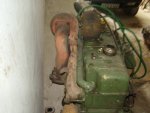
This is a turbo OM352A viewed rear-to-front, and it shows the location of the turbo and how it's a bit higher than the engine would be without it. If you didn't want to lift the cab up, you'd have to cut away at the top edge of the engine compartment bulkhead (which you'd consider the firewall on a vehicle that didn't have half an engine on either side). You'd also have to get some clearance in the engine doghouse.
Both operations would be difficult-to-impossible given that the top of the engine and the engine doghouse are really close to the same height as the bottom of the windshield. So inserting the turbo engine without the cab lift would probably require the center-bottom of the windshield to be modified in some way. (As mentioned in this morning's post, it might work to remove the turbo from the top of the engine and connect it up mounted somewhere else in the engine compartment. Then again, it might not. The cab lift is the usual procedure when turbocharging 416s with regular cabs.)
Forum statistics
- Forums
- Classified
- For Sale and Wanted Section
- Expedition Vehicles
- For sale - By ExPo members (*With Price*)

